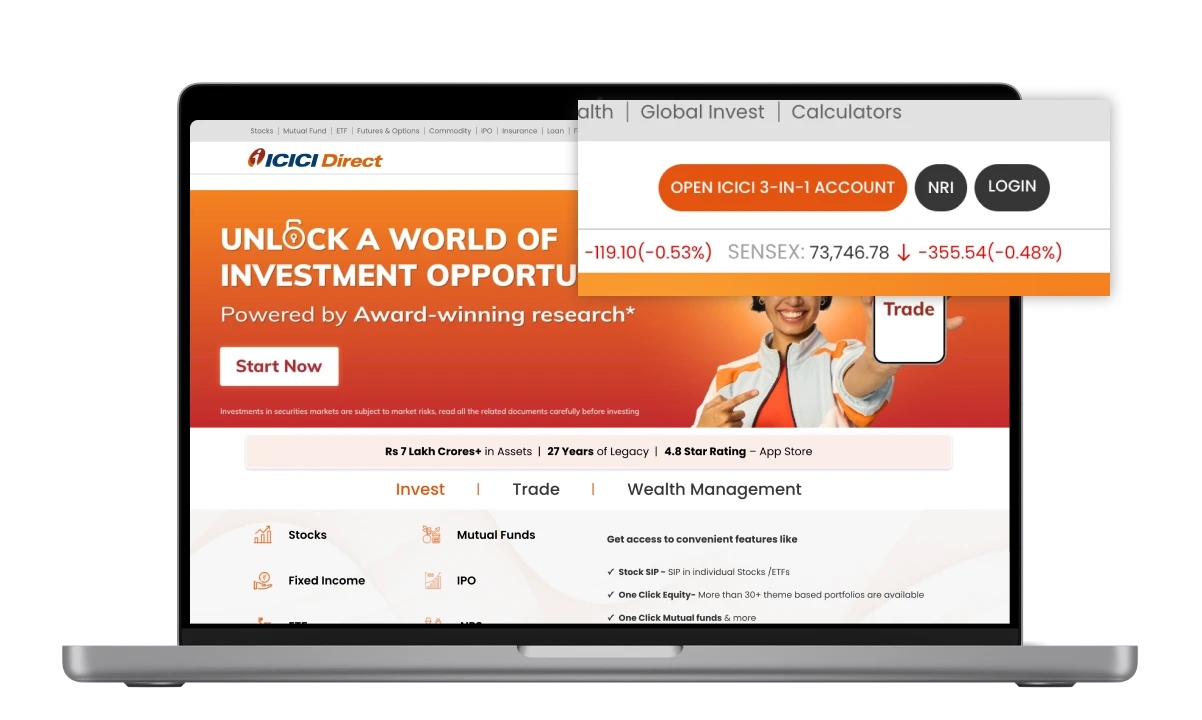How to apply an IPO on ICICI Direct
Step 1:Log in to the ICICI Direct App/Website
Get started by logging in on the ICICI Direct app or website.
Step 2:Head to the IPO Section
Navigate to the IPO section.
Step 3:Apply for the IPO
Enter the number of lots, enter the bid price.
Step 4:Confirm Your Order
Confirm and submit your order.

What is an IPO?
Initial Public Offerings (IPOs) give you a front-row seat to invest in companies as they step into the public market.
An IPO allows investors to become shareholders or “part owners” of the company, while enabling companies to raise capital for various business needs, such as expanding operations or paying off debt.
Types of IPOs
There are two common types of IPOs: Fixed Price Issue and Book-Building Issue. The key difference lies in how the share price is determined.
Fixed Price Issue
In a Fixed Price IPO, the price of shares is pre-determined by the company and its lead managers. Investors know exactly what they will pay for each share at the time of subscription.
Book-Building Issue
In a Book-Building IPO, shares are offered within a price range, rather than at a fixed price. Investors place bids within this range, and the final price is determined based on demand and supply.
How an IPO Works
The journey of taking a company public involves several key steps. Here’s how the IPO process unfolds:
- The company decides to go public and conducts the necessary compliance checks and financial audits.
- It then files a Draft Red Herring Prospectus (DRHP) with SEBI and submits a separate application to the stock exchanges where it intends to list its shares.
- The company and underwriters promote the IPO, often through a roadshow.
- The offering price is determined based on market conditions, and the Red Herring Prospectus (RHP)—the final, comprehensive version of the prospectus—is updated with price details.
- Shares are allocated to the main investor categories: Retail Individual Investors (RIIs), Non-Institutional Investors (NIIs), and Qualified Institutional Buyers (QIBs). Investors interested in the offering can bid when the IPO opens for subscription.
- The company gets listed on stock exchanges such as NSE and BSE.
- Trading begins when shares become available on the secondary market.
- The company continues to provide financial and operational updates to investors and exchanges during the post-IPO reporting period.
History of IPOs
The first ever IPO was issued by the Dutch East India Company (Vereenigde Oost-Indische Compagnie in Dutch). It also issued the first recorded stock certificate on the Amsterdam Stock Exchange, the world's oldest active stock exchange.
In India, the first company to go public with an IPO was Reliance Industries, which got listed on the BSE in January 1978.
IPO Application Process on ICICI Direct
Here are the main steps to invest in an IPO on ICICI Direct:
Open a Demat and Trading Account
A Demat account is essential for holding shares, while a Trading account allows investors to buy and sell them.
Research the IPO
Review the company's Red Herring Prospectus (RHP) to understand its business, financials, and risks. Uncertain investors can also consult a financial advisor for insights.
Apply for the IPO
- Navigate to the IPO section on the ICICI Direct App or website
- Enter the number of lots you wish to bid for and enter a bid price
- Complete the application by submitting the bid and accepting the terms and conditions
- Click on “confirm” to proceed.
Check IPO Allotment Status
Once the IPO closes, check the allotment status on “order book” on the ICICI Direct app/website.
Advantages and Disadvantages of IPOs
Here are the main advantages and disadvantages of investing in an IPO:
Advantages of Investing in an IPO
Early-Stage Investment Opportunity
Investors can participate in a company’s growth at an early stage, often at cost-effective prices.
Potential for Capital Appreciation
If the IPO is successful, share prices may rise, offering significant returns in the form of capital appreciation.
Access to Innovative Companies
Investors get an opportunity to invest in exciting, high-growth companies that were previously private.
Liquidity and Flexibility
Once listed, shares can be traded freely, offering liquidity (subject to lock-in rules, if any).
Disadvantages of Investing in an IPO
Higher Risk Exposure
Newly listed companies may lack a proven track record, making them a riskier investment.
Price Volatility
Recently listed stocks can be highly volatile in the initial trading phase, leading to price fluctuations.
Possible Overvaluation
Some IPOs may be overpriced, leading to sharp price corrections post-listing.
Lock-in Restrictions
In some cases, investors may be unable to sell shares immediately due to a lock-in period.
Why Would Companies Release an IPO?
Here’s a look at why companies go public:
- Raising Capital: The primary reason for an IPO is to raise funds for business expansion, debt repayment, or other strategic initiatives. Additionally, companies can issue more shares in the future through a Follow-on Public Offering (FPO).
- Prestige & Brand Awareness: Getting listed on the stock exchange enhances a company’s credibility and visibility. It also boosts brand awareness among the general public and potential investors.
- Liquidity and Realising Gains: Existing shareholders, including founders and early investors, can sell part of their stake to realize gains and enhance liquidity.
- Wider Range of Investors: Going public attracts a diverse pool of investors, including institutional investors (mutual funds, insurance companies), high-net-worth individuals (HNIs), and retail investors.
What is the IPO Timeline?
Launching an IPO in India is a multi-stage process involving regulatory approvals, financial audits, and investor allocation. The entire process typically takes 3 to 12 months and includes the following key phases:
Pre-IPO Planning – Identifying the financial statements and disclosures to be included in the prospectus.
Due Diligence & Compliance – Conducting financial audits and ensuring legal compliance.
Drafting the DRHP – Preparing the Draft Red Herring Prospectus (DRHP) and the registration statement.
Appointing a Merchant Banker – Selecting an investment bank or financial institution to manage the IPO process.
SEBI Approval & Exchange Listing – Securing approval from SEBI and applying for stock exchange listing.
IPO Opens for Subscription – Investors can apply for shares during the subscription window.
Share Allotment & Listing – Finalizing share allotment and listing the company on the stock exchange.
Is it Good to Invest in an IPO?
Investing in an IPO comes with both opportunities and risks, as outlined in the ‘Advantages and Disadvantages of IPOs’ section. However, the decision to invest in a specific IPO depends on several key factors such as:
Business Model & Industry Position: Understanding the company’s core operations, competitive edge, and market standing.
Financial Performance & Growth Potential: Evaluating the company's revenues, profitability, and expansion plans.
Valuation & Risk Factors: Comparing the IPO pricing with industry benchmarks and potential risks.
Market Sentiment: Considering broader market trends and investor interest in an IPO.
Before investing, it is crucial to research the company and review its Red Herring Prospectus (RHP). If unsure, investors may also seek guidance from a financial advisor.
Related articles on IPO
View all
How can investors evaluate the potential of an IPO?
Investing in an Initial Public Offering (IPO) can be an exciting opportunity, but it also comes with risks. In this article learn about the checks to perform brfore investing in IPO

Sai Life Sciences IPO Allotment Status
Learn how to check Sai Life Sciences IPO allotment status online

Vishal Mega Mart IPO Allotment Status
Learn how to check Vishal Mega Mart IPO allotment status online
Frequently Asked Questions
What is the IPO Cycle?
The IPO cycle refers to the various stages a company goes through before, during, and after launching an IPO. It includes:
- Pre-IPO Phase – This place includes planning, compliance checks, financial audits, and SEBI approvals.
- Offer Period – Here, the IPO opens for subscription, and investors place bids.
- Allotment & Listing – In this phase, shares are allocated, and the company gets listed on the stock exchange.
- Post-IPO Compliance – Post-IPO, the company must adhere to SEBI regulations and provide periodic financial disclosures.
What is the Difference Between an FPO and an IPO?
In an IPO (Initial Public Offering), a company offers shares to the public for the first time, transitioning from private to public ownership.
In an FPO (Follow-on Public Offering), an already listed company issues additional shares to raise more capital.
What is Lot Size in an IPO?
‘Lot Size’ is referred to as the minimum number of shares an investor must apply for in an IPO. IPO applications are placed in multiples of the lot size. For example, if a company sets the lot size at 40 shares, then an investor can apply for 40, 80, 120 shares, and so on.
What is an Offer for Sale (OFS) in an IPO?
An Offer for Sale (OFS) is when existing shareholders (like promoters or early investors) sell their shares in an IPO as opposed to the company issuing new shares. The proceeds from the OFS go to the shareholders selling their stake and not the company.
Can We Apply for an IPO After Market Hours?
While you can apply for an IPO even after market hours through your broker’s online platform, exchanges accept applications only from 10 AM on the day it opens until 4:30 PM on the day it closes.






